Guessing the outcome of an America’s Cup isn’t meant to be easy, but the majority of pundits seemed so taken by the revolutionary solid wing rig of BMW Oracle racing to do anything other than believe that the Americans would win.
The bookmakers agreed, with only very short odds available on the American team compared with the Swiss. It looked like a classic case of everyone getting carried away with one piece of sexy technology and ignoring the bigger picture. After all, this was the invincible Alinghi - the dominant force of the America’s Cup for the past decade - that the wing rig had to beat. Silver bullets have so often proved to be a disappointment, and an irrelevance. Remember that double-bottomed innovation called the ‘Hula’, which Team New Zealand believed would be their ‘killer app’ for their 2003 defence of the Cup in Auckland? How wrong they were, as their mast snapped in one race and they went down 5-0 to Alinghi’s more conventional but proven boat.
On the other hand there was the winged keel which propelled Australia II to that famous victory in Newport 1983. So were we on the verge of witnessing another technological breakthrough? Was USA-17, like Australia II, set to become another epoch-defining winged wonder?
While some of my colleagues were placing bets of hundreds of pounds on Larry Ellison’s team to win, I really wasn’t so sure. Surely Ernesto Bertarelli’s team couldn’t have got it that wrong, could they?
Then again, the Swiss found themselves having to race in a venue not of their choosing. Their lightweight catamaran, Alinghi 5, had been optimised for very steady light breezes and flat water off the coast of Ras Al Khaimah. Instead they found themselves in the far less predictable conditions of winter-time Valencia.
Also, they had failed to impose their demand to run races in strictly defined conditions: waves of no more than 1 m in height, and winds not exceeding 15 knots as measured at 60m above sea level, in other words at mast height.
It was fascinating observing both teams in the final days before Race One. Both teams appeared to exude confidence, but there was an added twinkle in the eye of some of BMW Oracle’s leading lights such as Russell Coutts, who appeared ever more confident of their wing rig’s potential. Bear in mind that they had only been trialling this 223-foot solid wing for a matter of weeks, so they were learning new things every day about its performance.
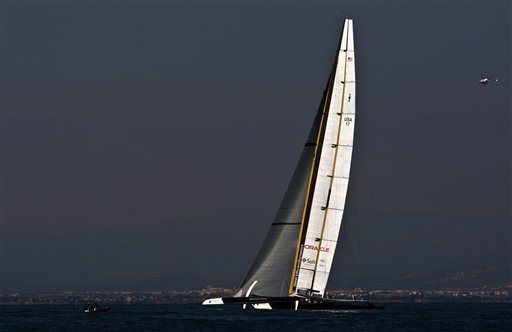
© AP Photo / Daniel Ochoa de Olza
The greater concern for BMW Oracle was not so much what the wing might do on the racecourse, but what mischief it might get up to at night. Lifting the wing rig in and out of the boat had been a logistical nightmare, and was the time when the wing was in greatest danger of being damaged, or causing damage to the trimaran. Then again no one was quite sure in how much wind they could afford to keep the wing rig up when moored in the commercial port of Valencia. A night watch of employees and enthusiasts would sit on the boat each and every night, ready to react if the wing started getting frisky. Self-confessed enthusiasts of this 22-storey beast, they came to be known as the “wing nuts”. The team’s design team director, Mike Drummond, likened looking after the trimaran to “babysitting King Kong”.
Alinghi’s conventionally rigged and smaller catamaran gave them no such logistical issues, but both teams were aware just how fragile their light-wind, light-weight machines were.
Finally, after two and a half years of frustration, with endless legal challenges and bickering over the tiniest difference of opinion, these two teams were about to start racing. But it was clear that the personal enmities remained as strong as ever. When the organisers called an owner’s press conference the day before Race One was set to take place, BMW Oracle wanted to send Russell Coutts in place of Larry Ellison. The organisers said no, so Ellison refused to show, and Bertarelli went up to face the media alone.
“I came here determined to shake hands and here I am, available, and he's not here,” said Bertarelli.
It was interesting to note the teams’ differing predictions over whether or not match racing would play a part in the outcome of the 33rd America’s Cup. Most predicted a remote, clinical match decided not by aggression but by superior technology and boat speed. The fact that Ernesto Bertarelli had appointed himself helmsman of Alinghi 5 suggested the Defender wasn’t expecting to engage in much hand-to-hand combat. The team’s top match race talent, Ed Baird, stood aside from the wheel for his boss. A good multihull helmsman the billionaire may be, from all his years’ experience racing on Lake Geneva, but a veteran match racer he was not.
The 30-year-old Jimmy Spithill on the other hand was already established as one of the world’s great match racers. For the past two years he has put himself through an intensive programme of mastering the peculiar skills of multihull sailing, training on boats such as Open 60 trimarans, Extreme 40 catamarans and even singlehanded A-Class cats.
It was unthinkable that anyone would dare put these fragile, multi-million dollar machines into close-quarters combat. But one of the BMW Oracle crew, mast man Matt Mason suggested otherwise: “There are probably going to be two different philosophies about the pre-start,” he said. “I know that Jimmy is pretty fired up about it. The five minutes is going to go very fast. They have the offset entry for the port entry boat. But there is a chance that the starboard entry boat could catch the port entry even though they have that offset. And using a downwind sail on the entry is an option. And I know that if we have the chance we will be entering with a downwind sail and trying to get a piece of them and engaging pre-start. That’s our plan.”
Big talk. But was that all it was? We didn’t have to wait long to find out. Well, actually, we did, because Race 1 was meant to take place on Monday 8 February. However, a lack of stable wind that day caused principal race officer Harold Bennett to send the teams back in again. With racing scheduled only every other day, we waited for Wednesday, but on this occasion it was deemed too windy. Journalists were getting restless by this time, some accusing Bennett of being in the pocket of Alinghi. How wrong they were, as we would later discover. Eventually after a morning’s postponement, Race 1 got underway on Friday afternoon. It was a humdinger.

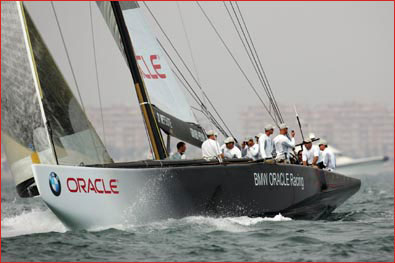 BMW Oracle has been carrying out some extensive TV trials of monohulls and multihulls in Valencia. The aim, says the Defender, is to work out which kind of boat is going to offer the biggest bang for buck in Russell Coutts’s vision of a more media-friendly and commercially-attractive America’s Cup...
BMW Oracle has been carrying out some extensive TV trials of monohulls and multihulls in Valencia. The aim, says the Defender, is to work out which kind of boat is going to offer the biggest bang for buck in Russell Coutts’s vision of a more media-friendly and commercially-attractive America’s Cup...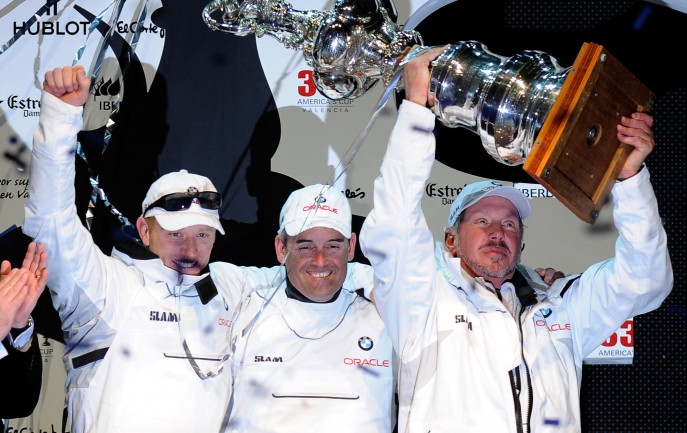 So now we’ve seen the power of wing rigs in action in the America’s Cup, what possibility of a trickledown of technology into other forms of sailing? What about superyachts? BMW Oracle’s design team director Mike Drummond observed, tongue in cheek: “If you go to Wings R Us.com, you can get any size you like.” Of course, this technology is anything but off the shelf, but nor is it new, as Drummond also pointed out: “Wings are not new, they’ve been used by birds for quite a long time...
So now we’ve seen the power of wing rigs in action in the America’s Cup, what possibility of a trickledown of technology into other forms of sailing? What about superyachts? BMW Oracle’s design team director Mike Drummond observed, tongue in cheek: “If you go to Wings R Us.com, you can get any size you like.” Of course, this technology is anything but off the shelf, but nor is it new, as Drummond also pointed out: “Wings are not new, they’ve been used by birds for quite a long time...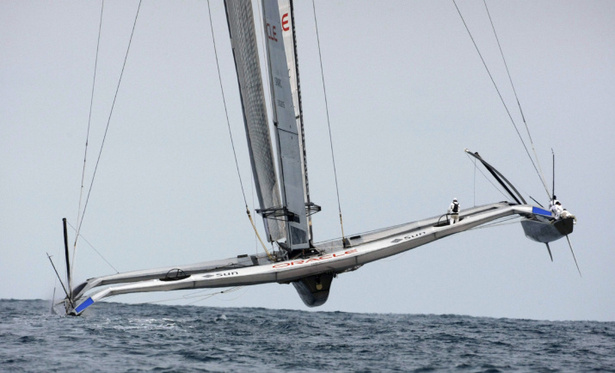 So now we know. Wings trump sails. Theory has always stated that a wing rig should be faster than conventional sails. But the challenge was actually to put a wing rig into practice, to be able to build it in less than six months, and also to manage the logistics of it...
So now we know. Wings trump sails. Theory has always stated that a wing rig should be faster than conventional sails. But the challenge was actually to put a wing rig into practice, to be able to build it in less than six months, and also to manage the logistics of it...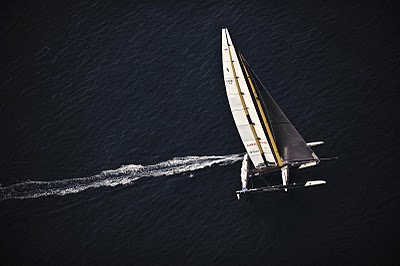 Race 2 was set to take place two days later on the Sunday. It was another long wait while Harold Bennett looked for suitable conditions in which to start the race. The cut-off time of 4pm was just minutes away when Bennett called for the start procedure to begin...
Race 2 was set to take place two days later on the Sunday. It was another long wait while Harold Bennett looked for suitable conditions in which to start the race. The cut-off time of 4pm was just minutes away when Bennett called for the start procedure to begin... The wind was light and patchy that day, with Harold Bennett waiting for the breeze to settle. Alinghi clearly wanted to get on with it, flying a hull right past Bennett’s committee boat. BMW Oracle gave the impression of being rather more reluctant...
The wind was light and patchy that day, with Harold Bennett waiting for the breeze to settle. Alinghi clearly wanted to get on with it, flying a hull right past Bennett’s committee boat. BMW Oracle gave the impression of being rather more reluctant...